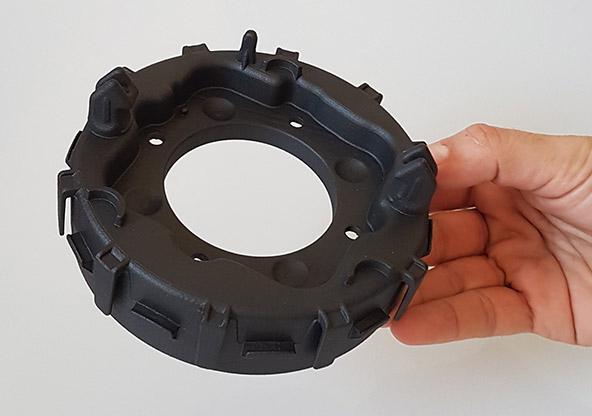Editor-in-Chief
- FMA
- The Fabricator
- FABTECH
- Canadian Metalworking
Our Publications
Categories
- Additive Manufacturing
- Aluminum Welding
- Arc Welding
- Assembly and Joining
- Automation and Robotics
- Bending and Forming
- Consumables
- Cutting and Weld Prep
- Electric Vehicles
- En Español
- Finishing
- Hydroforming
- Laser Cutting
- Laser Welding
- Machining
- Manufacturing Software
- Materials Handling
- Metals/Materials
- Oxyfuel Cutting
- Plasma Cutting
- Power Tools
- Punching and Other Holemaking
- Roll Forming
- Safety
- Sawing
- Shearing
- Shop Management
- Testing and Measuring
- Tube and Pipe Fabrication
- Tube and Pipe Production
- Waterjet Cutting
Industry Directory
Webcasts
Podcasts
FAB 40
Advertise
Subscribe
Account Login
Search
Shop 3D-prints diverse range of devices
CRP Technology’s sample book of 3D printing jobs showcases AM’s versatility
- By Don Nelson
- June 18, 2020
- Article
- Additive Manufacturing

CRP Technology 3D-printed a deployer for PocketQube miniature satellites, which are 5 cm cubes that weigh less than 250 g. Alba Orbital
If you like stories about 3D-printing parts from polyimide-based materials—and who doesn’t?—then you’ll probably enjoy reading case studies posted to the CRP Technology website.
Many of the parts and devices the Italian 3D printing company builds are interesting and illustrate additive manufacturing’s versatility. A recent job was 3D-printing deployers for Alba Orbital’s PocketQube miniature satellites, which are 5 cm cubes that weigh less than 250 g.
Other examples of CRP Tech’s work range from column capitals to custom face masks to motorcycle brake arms to futuristic tennis rackets to drones.
The latest case study is about prototyping a driver airbag (DAB) housing. CRP Tech used a selective laser sintering (SLS) printer to build the housing from its Windform SP carbon-reinforced composite.
The customer, Joyson Safety Systems, Auburn Hills, Mich., produces safety-critical components and systems for the automotive industry. These include airbags, seatbelts, steering wheels, and safety electronics.
The airbag system comprises an inflator and airbag cushion, a cover, and the housing, which attaches to a vehicle’s steering wheel. When deployed, the airbag inflates in 30 to 50 milliseconds. The DAB housing holds the airbag system in place.
The housing material, which is injection-molded from a 40% glass-fiber-reinforced polyamide, must have excellent strength, impact resistance, and thermal stability.
A while ago, Joyson began investigating ways to improve the housing. Part of the effort involved identifying a composite for 3D-printing prototypes that exhibits mechanical, thermal, and performance characteristics like the glass-fiber polyamide. The Michigan company also wanted a functional prototype that could be tested at operating temperatures and be completed much more quickly than would be possible with conventional methods.
Joyson said Windform SP exhibited “excellent mechanical performance in terms of high strength and impact resistance, as well a good thermal stability between a low and high range of temperatures” (-35 to 85 degrees C). CRP finished the prototype in a little more than three weeks. That job performed by conventional processes typically would take 12 to 17 weeks, according to Joyson.
A member of the Joyson team said the positive experience with Windform SP and the prototyping work could lead to further projects with CRP Tech.
CRP Technology has offices in Modena, Italy, and Mooresville, N.C. It is part of CRP Group, which specializes in highly technical machining and 3D printing applications, as well as rapid casting, R&D, reverse engineering, and developing AM composite materials. It also has a division that manufactures electric motorcycles.
About the Author

Don Nelson
2135 Point Blvd.
Elgin, IL 60123
(815)-227-8248
About the Publication
- Podcasting
- Podcast:
- The Fabricator Podcast
- Published:
- 04/16/2024
- Running Time:
- 63:29
In this episode of The Fabricator Podcast, Caleb Chamberlain, co-founder and CEO of OSH Cut, discusses his company’s...
- Trending Articles
- Industry Events
16th Annual Safety Conference
- April 30 - May 1, 2024
- Elgin,
Pipe and Tube Conference
- May 21 - 22, 2024
- Omaha, NE
World-Class Roll Forming Workshop
- June 5 - 6, 2024
- Louisville, KY
Advanced Laser Application Workshop
- June 25 - 27, 2024
- Novi, MI



























